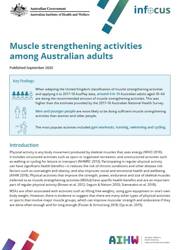Summary
Physical activity is any body movement produced by skeletal muscles that uses energy (WHO 2018). It includes structured activities such as sport or organised recreation, and unstructured activities such as walking or cycling for leisure or transport (NHMRC 2013). Participating in regular physical activity can have significant health benefits—it reduces the risk of chronic conditions and other disease risk factors such as overweight and obesity, and also improves social and emotional health and wellbeing (AIHW 2018). Physical activities that improve the strength, power, endurance and size of skeletal muscles (referred to as muscle strengthening activities (MSAs)) have specific health benefits and are an important part of regular physical activity (Brown et al. 2012; Seguin & Nelson 2003; Stamatakis et al. 2018).
MSAs are often associated with activities such as lifting free weights, using gym equipment or one’s own body weight. However, there is evidence to suggest that there are many other types of physical activities or sports that involve major muscle groups, which can improve muscular strength and endurance if they are done often enough and for long enough (Foster & Armstrong 2018; Oja et al. 2015).
This report describes the guideline for MSA included in Australia’s Physical Activity and Sedentary Behaviour Guidelines (Department of Health 2019). It discusses what types of activities may be considered MSAs using different definitions, and why MSAs are important for health. It presents estimates from the 2017–18 Australian Bureau of Statistics National Health Survey (ABS NHS) of how many Australians do the recommended amount of MSAs. Results from an analysis of Sport Australia’s AusPlay survey (AusPlay) data are also presented, to provide alternative estimates of how many Australians may be doing sufficient MSAs when a wider range of MSAs than those mentioned in the ABS NHS are included.



